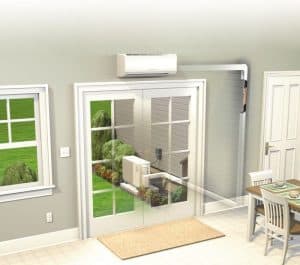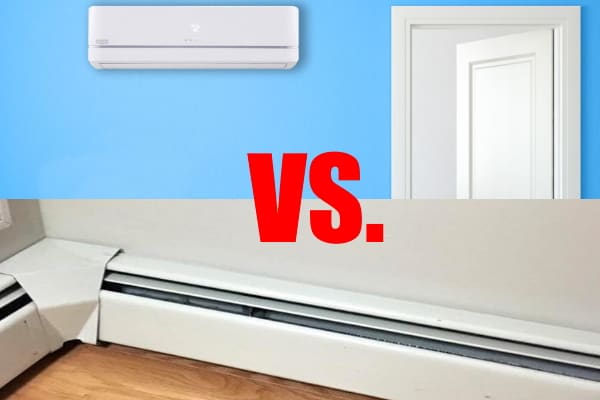Baseboard heat has been a popular heating option for decades. Installing these heaters along the floorboards in each room is easy and doesn’t take up much space. It used to be one of the best options for your homes without ductwork. But today, ductless heating and cooling give it a run for its money.
In this article, we’re putting these two heating options side-by-side to help you determine what’s best for your home. We’ll examine:
- Performance
- Pricing
- Installation
- Energy Efficiency
To be upfront, we here at Snowflake air are big proponents of ductless for homes in Eagle, ID. We’ve seen the benefits they offer, and we’ve had so many satisfied customers in Treasure Valley. But there are pros and cons to mini splits.
So, let’s take a closer look at both options.
What is Ductless Heating and Cooling?
Ductless heating and cooling is usually set up as a mini split with indoor and outdoor components. Outside, you have a heat pump that either draws in heat or gets rid of it. Inside are air handlers in each room you’re treating.
These heat or cool the air in the room. You can go with a single-zone setup that treats one room – especially useful for garages, third floors, and attics. Or, add air handlers wherever you want them in the house, up to and including treating your entire home with this system.
Finally, there’s a line of narrow flexible piping containing refrigerant fluid, or coolant, that connects the air handlers and heat pump. The coolant either carries the heat from the pump to the handlers or vice versa.
This is a quick overview, and you can read more about how mini splits work. But, now that you have an idea let’s see how this stacks up against baseboard heat.
Performance
Mini splits take an early lead when it comes to just how well they work. And, for many people, this is the most important factor. But, it’s not the only one, so keep reading.
With baseboards, electricity heats the coils that radiate heat out into the room. It’s why these work without attaching to a bigger system. The entire process occurs right in the room.
They do a decent job. But, ductless does it better.
Air handlers use specialized sensors and fans to locate hot or cold spots in a room and direct the treated air to where it’s needed the most.
As a result, the room gets to the temperature you want faster than with baseboards (or radiators or forced-air for that matter). Mini splits makes each room much more comfortable than other heating and cooling systems.
You’ll also note that we mentioned hot and cold spots. That’s because ductless heating and cooling provides both heating and air conditioning. Baseboard units only provide warmth.
Pricing
If you’re on a budget, baseboard heating is the way to go. Mini splits are a lot of things, but they’re not cheap. A one-zone system that treats a single room starts around $3,500. When you go multi-zone, the price goes up with each air handler. Most whole-home solutions cost around $17,000.
Read More: What is the Cost of a Ductless Mini Split in Boise Metro and Valley County?
By contrast, you can heat a room with baseboard units for well under $300.
Now, there’s more to the equation. For instance, like just about all utilities in the country, the Idaho Power Company will give you a rebate for going ductless. We’ll explain why in a bit.
But, upfront, baseboards come in way cheaper.
Installation
This one’s a close call. Baseboard heating is easier to put in, but not by much at all. And, both are way simpler than a new forced-air system with ductwork.
With baseboards, you attach the unit to the wall and run the power line. Ductless takes a little more.
You mount the heat pump outside and mount the air handlers to the walls. The tricky part is linking the components with the coolant lines. But, since they’re narrow and flexible, it’s easy to run them through the walls. We make the holes behind the air handlers, so you don’t see the openings at all.
We should note that both are virtually silent. Again, a leg up on ductwork and vent, but a tie for these two.
Finally, mini splits are more out-of-the-way. Most air handlers end up mounted high on the wall. So, there’s no problem with kicking or otherwise damaging them.
You also don’t have to worry about pets or young children burning themselves by getting too close like you do with baseboard heaters.
Read Mini Split Installation Case Studies In Your Area
Energy Efficiency
 In our opinion, this is where mini splits leave baseboard heating in the dust. Sure, the upfront cost for ductless is way more. But, month after month, you’ll pay much, much less on your energy bills. Eventually, the system pays for itself.
In our opinion, this is where mini splits leave baseboard heating in the dust. Sure, the upfront cost for ductless is way more. But, month after month, you’ll pay much, much less on your energy bills. Eventually, the system pays for itself.
There are three significant differences. The first involves the heat pump.
Your ductless system doesn’t burn fossil fuels to generate heat. Instead, the heat pump draws in whatever heat, or thermal energy, is outside, even in the winter. Then, it amplifies that energy until it’s strong enough to heat your home.
This process takes a tiny fraction of the electricity that a baseboard heater uses to warm the coils until the room starts getting warm.
Then, you have those specialized sensors and fans we talked about. Since they treat the room quickly, it takes less energy to get the job done.
Finally, there’s inverter technology.
Instead of cycling on and off a few times every hour, ductless heating and cooling spend most of the time in a low-power mode that continuously maintains the temperature.
That takes way less energy than clicking on and off every time the temperature drifts. It’s like how a car always stopping and starting uses more gas than when you’re coasting on the highway.
That’s why Idaho Power Company gives you a rebate: They’re incentivizing low energy usage. These systems fit that bill.
Mini Split Installation in Eagle, ID, Boise Metro, and Valley County
At Snowflake Air, we recommend mini splits for Eagle, ID homes over baseboard heating. There may be some situations where cost or installation is a problem. But, by and large, ductless heating and cooling is more effective, more efficient, and makes your home more comfortable.





Trackbacks/Pingbacks